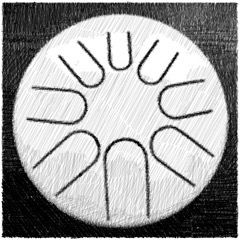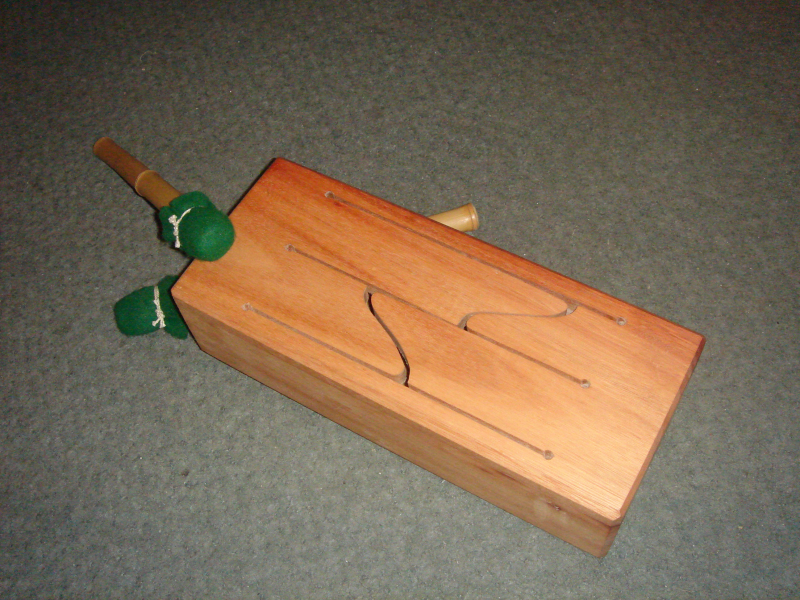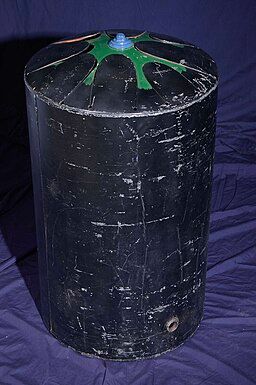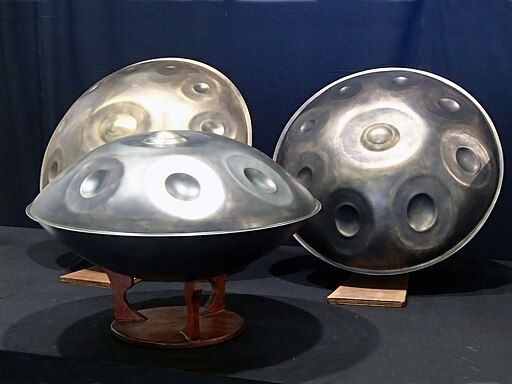History of the Steel Tongue Drum

The tongue drum is often accused of being a poor person’s handpan, but that’s not the case at all. The tongue drum was not based on the Hang Drum and predates PANArt’s creation by almost a decade. This article digs into the true roots of the tongue drum, the connection with the handpan, and the tongue drum’s continual development over its short history.
Prehistory: Origins

The steel tongue drum is actually based on the wooden slit drum. The slit drum seems to have developed independently with Aztecs, Africans, Indonesians and others cultures. It predates modern music by thousands of years. Slit drums were made from a hollowed log or bamboo and were struck with sticks. They were used for both ritual and communication and were tuned to two or more pitches. More refinement came when tongues of specific pitches were cut and the drum became known as the wooden tongue drum.

1990: From wood to tank

The tongue drum migrated from wood to steel in 1990 when Jim Doble came up with the Whale Drum. I’ll let Jim tell it: “I had made some wooden bass tongue drums, and think I happened to glance at an old water tank I had in my yard, and went”huh, I wonder…“. Much larger than today’s tongue drums, Jim’s original concept of a tank with tuned tongues cut in the end is the same used in tongue drums today. Most of Jim’s large drums over the last 30 years are playable art that have found their way onto school playgrounds and into children’s museums.
1999: The handpan connection

There are similarities between the sound of a handpan and a tongue drum since both instruments are metal and classified as idiophones (where the body of the instrument generates the sound.) In 1999, Felix Rohner and Sabina Schärer of PANArt, a Swiss workshop that crafted Caribbean steel drums, came up with the idea of combining the steel drum with the Javanese ageng gong (with its distinctive hump in the center). At the original price of $400, their limited production couldn’t keep up with demand and prices for used PANArt Hang Drums sailed up into the thousands of dollars. By 2014 they had quit making them, but later revived production and now call their copyrighted model the Hang Sculpture. Today a new handpan from PANArt is harder to get than ever and sells for about $3,000. By contrast many quality tongue drums today sell for less than that original $400 price of the handpan.
2005: The Tambiro
Around 2005, percussionist Felle Vega from the Dominican Republic cut tongues in the side of a smaller propane tank and called it the Tambio. He’s never produced it commercially.
2007: The modern tongue drum

Dennis Havlena was fascinated with the handpan. But finding it impossible to get one, he took Felle Vega’s concept of tongues on the side of a propane tank and moved them to the top, similar to what Jim Doble had done almost two decades before. As a play on hang drum, Dennis named it the hank drum and made his DIY plans freely available on the internet. This helped establish the 12-inch, eight-note tongue drum created from a propane tank as the standard that builders across the world worked from.

Also in 2007, Federico Parra and Ary Lacanna of Garrahand (now GDrum) in Argentina created a smaller, tall, 7-note drum with tongues of three different shapes. These drums are usually played in sets of two.
2008: A tongue drum in every home?
Graham Doe of Hapi Drum started working from Dennis Havlena’s design in 2008. He patented his own tongue layout that placed larger tongues at compass points of north, south, east and west and four smaller tongues in between.
One of the traits of a tongue drum made from a steel propane tank is that the sustain is longer than a handpan. (On the handpan thinner metal, proximity of notes and tongueless playing areas absorb the sustain more quickly and create somewhat of a “wah” sound as overtones die.) Graham sought to tame the tongue drum sustain a bit so he also added nickel to the steel. He also found a shop in India that could produce high-quality drums for him at a reasonable cost. This helped establish today’s low price point for tongue drums.
2009: The tunable tongue drum
Deniz Gungor in Turkey started building the Aquadrum based on Dennis Havlena’s design. His Aquadrum Pro added a patented system of tuning magnets that could easily be moved with a screwdriver through slits in the tongues. This made the tongue drum even more cost effective with one drum capable of many keys and tunings.
2010: Tongue drums introduced to stadiums-full
Gdrum would add an elaborate pickup system designed to capture the distinct sound of each tongue. It made the tongue drum easy to use live. By just plugging in, world-music drummers could add GDrums to their stage kits. Sting, Bork and Peter Gabriel are among the many who introduced the tongue drum to stadiums full of people, but it still remained a novelty.
2013: The handpan and tongue drum had a baby
Like most people, Russian engineering student, Andrey Remyannikov, couldn’t justify the cost of a hang drum. So he spent 18 months creating a drum with the saucer shape and metal thickness of a handpan, but with tongues cut into it. He called it the Rav Vast. It’s often confused with a HandPan, but it’s definitely a tongue drum.
Coincidentally, the same year Max Plakhtin and Alex Lozhkin at Zen Percussion created the Guda Drum with a similar saucer shape with tongues on top.
2016: Enter the cheapies
Around 2016, numerous factories in China started pouring out tongue drums from steel or alloys that add tungsten or aluminum. Though still handmade, these vary greatly in quality, pitch, tone and price with many selling for less than $100. The resulting alloy may not be magnetic, making it impossible to use magnetic pickups on some models. While there are bargains to be had, it’s difficult to determine quality by price or biased online reviews.
The result of this flooding the market with Amazon-deal tongue drums is that everyone can afford one and more potential players get exposed to the instrument. Very typically the curious will start with a cheap tongue drum or two before investing $300 to $800 on a quality instrument.
2018: Beat the drum electric
In 2014, Julien Puget of France crowdfunded the launch of Beat Root Tongue Drums. By 2018, the line featured the Multiscale with a simple, magnetic-tuning system and a built-in, piezo pickup.
2020: Handpan makers hung out to dry
The handpan now sits at the center of a European Court of Justice decision that threatens the popular existence of the instrument, but not the tongue drum. The court ruled that the Hang qualifies as a “work of applied art”. As a “sound sculpture”, PANArt has far-reaching copyright protection over Handpan production. This ruling bans any maker in the EU from producing handpans without permission from PANArt and PANArt doesn’t currently license their design, claiming no one is up to their quality standards. Many builders and players would disagree. And many makers in EU jurisdiction are trying to figure out how to comply or fight the ruling.
The flip side of the decision is that legally, a tongue drum is not a handpan. The open-source nature of the tongue drum remains intact and the tongue drum can advance without restrictions. It also means the new handpan supply will be more limited to new drums produced in countries like England and the US that don’t fall under EU jurisdiction and the few new ones produced by PANArt. (In the US, copyright specifically applies to the intellectual property of content and not devices. A US patent would no longer apply to a handpan due to the age from creation.) Expect used handpan prices to increase even more. As this happens tongue drums become a more practical option for idiophone players.
Russia is an EU member and the country had been a hotbed for handpan shops. Rav, the largest player, seems to have complied and stopped making handpans. They now focus on the Rav Vast. While a saucer-shape like the Hang, the tongues exempt them from the copyright.
From novelty to standard instrument
The under-$100, sweatshop-made tongue drums from China have increased the instrument’s popularity, but they’ve also created an image problem: Since everybody can own a cheap one, they also have left the instrument regarded as a toy in the eye of the public. Fortunately on the flip side, higher-quality tongue drums are finally gaining respect as the amazing instruments they are. Soundiron recently produced a high-quality sample library of Hapi Drums. Tongue drum iOS apps are starting to pop up in the App Store. Due to the availability, lower price and ease of play, tongue drums are supplanting handpans as instruments for therapy, meditation and yoga.
The future

The open-source tongue drum continues along a path of musical innovation, while the ruling keeps the handpan somewhat locked at its year-2000 design. While possible to create a hang-type drum (without tongues) that doesn’t violate the copyright, the ruling is so new we’re not seeing much movement on the front of legal challenges that better define the ruling. Meanwhile the tongue drum continues to evolve:
- Tunable tongue drums allow players to work in different scales and keys Any steel tongue drum you can get your hand inside can be pitched with magnets. However, some newer drums are alloy and don’t work with magnets.
- More range gets added The number of tongues on a tongue drum range from about 5 to about 15 on one side. Double-sided tongue drums are often built to be flipped to give you a different scale. But a second side can also add higher or lower notes that can be played from underneath.
- A big recent jump is the the multi-slit tongue by makers like Guda and Kosmosky in Russia. These can generate multiple notes and whole chords when your hit a tongue. Each tongue is capable of a variety of tones depending on where you hit the tongue.
- Sine Studio in Taiwan has a smaller drum called the Mini, which has a small hole in the bottom that acts like a wah-wah or tremolo as you open and close it with a finger.
- Jim Doble continues to create amazing devices like the Beast and Yellow Submarine: giant two-sided idiophones you can crawl inside. “You play any of the tongues on one end and you get sympathetic vibrations coming from the other end, but with a slight beat frequency which makes a Wawa thing that tends to mess with the mind a bit.”

Though a decade older than the handpan, the tongue drum is just getting started. From its beginnings as a discarded tank, we can expect to see the tongue drum refined and reshaped even more in the future.
Thanks to those who buy me a coffee below and make content like this possible.
